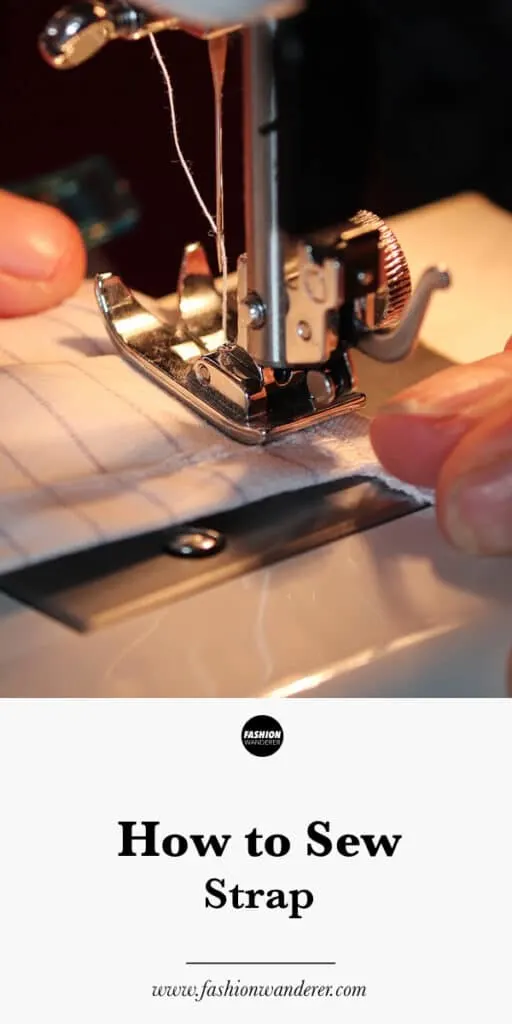Whether you are making spaghetti straps or adjustable straps for a top or dresses, understanding the proper way to make straps is important. Not only do strap need to fit perfectly so they look flattering, but they also offer more comfort and support to the garment.
There are multiple ways to make straps with leftover scrap of fabrics with a sewing machine and basic sewing tools. Let’s cover the basics for sewing straps.
How do you make straps? Follow the instructions to cut in bias or grain line around 2” in width and the desired length. Fold the strap in half and straight stitch to join, then use loop turner or safety pin to flip the strap inside out.
For wider straps, it is easier to fold the seam allowance inside and edge topstitch without flipping inside out.
If you have basic sewing skills and the required equipment including reading sewing patterns, this article will provide guidelines to make straps easily. Be it spaghetti straps, fabric straps or shoulder straps, they are great for sewing clothes, crafting, upcycle clothes, and modifying new styles.
How to make fabric straps?
Depending on the style of the garment, narrow or wider straps may complete the desired look. In this step by step tutorial, you will learn how to make a fabric straps that result in one inch width.
If you need narrow or wider, simply add or subtract width when cutting the fabric.
How to make a fabric straps with 1” width:
- Cut: Take a piece of fabric and cut around 2” in width. Double the width for the cut as you shall be folding the edges back. Likewise, the length is also double the measure. Folding the strap in half and stitch together for cleaner edges.
- Spray back with adhesive: Only use this method for sturdy support when sewing flimsy or lightweight fabric to turn into a strap. Take a spray adhesive and place a newspaper to shield the work surface in a nicely-ventilated area. Lay down the fabric straps with the backside up and apply an even adhesive coat along the overall surface.
- Fold over: Fold over the fabric sides lengthwise to meet in the center of the backside. Work down until adhered.
- Press and cure: Place some heavy item on top of this folded side to ensure an even strap without any bubbles. Set for 30 minutes.
- Stitch the strap: Assemble the straps properly and stitch them along both edges of the strap with edge topstitch. The edges can be finished as per your project.
You may skip the spray back with adhesive method and simply fold the seam allowance inward and edge topstitch to join the straps together.
Or use a loop turner when sewn right side facing together.
The narrower the strap is then use a loop turner to make a strap and for wider strap use the method above.
How to make shoulder straps
Shoulder straps give a hang to the dress over your shoulders, which will ensure the dress fits well and does not slip off. It offers comfort and attraction to the wearer.
Generally speaking, shoulder straps are slightly wider than spaghetti straps. With the proper sewing technique, it is easy to execute the finishing of shoulder strap of your top and dresses quickly.
How to sew shoulder straps:
- Use 2 long-edged straps and two short-edged straps.
- Fold in half lengthwise.
- On longer edges, bottom pin at the seam allowance about ¼” and sew straight stitch along the ¼” mark.
- Secure with backstitch on both ends of the stitch.
- Take the loop into a hook and turn to the fabric right side.
- Press with iron.
- Bring the body piece and sew the strap at the place on the backside of the body piece.
- The hook is placed in.
- Now take the shorter strap and repeat the same while looping into the hook.
- Stitch it after looping into the hook on one side of the strap while the other to the body piece.
- The gap between the straps should be such that it fits onto the shoulder of a general size.
The shoulder strap varies in shape and size depending on your project. The additional short-edged straps help you to insert adjustable buckles for wide straps to make it adjustable strap for dresses.
You may disregard the short strap and use only long strap for clean look as well.
How to make spaghetti straps
The spaghetti straps are quite easy and simple to whip up to add to your summer dresses or camisole. The process is relatively simple, however the grain line and length of the stitch make a difference to the quality of the finished straps.
Some straps are cut on bias opposed to the straight grain to give a little stretch.
- Spaghetti straps begin with a long rectangle shape.
- Fold in half and iron to make a center crease.
- Straight stitch it along the lengthwise with desired seam allowance.
- Use a serger and overlock stitch for raveling or stretching fabric.
- Turn it inside out with a loop turner and then seal with a backstitch at both ends.
Spaghetti straps can be hard to turn inside out, especially the very narrow ones or slippery silk fabrics. When flipping the strap, trimming the seam allowance to ⅛” will help you to turn the fabric right side out.
Also, avoid hooking the loop turner close to the raw edge of the fabric as the fabric might rip when you start pulling.
Tips for sewing straps
When sewing straps it can be tricky with tiny, narrow straps or even thick heavyweight fabrics. But if you’ve made straps before, you realize how difficult and irritating this can be when turning the tubes right side out.
If you fabric does fray easily, then it creates more frustration.
Here are some tips for sewing straps:
- Ensure proper cording thickness to turn straps easily and quickly.
- Cording helps to turn loops conveniently without breaking thread.
- Cording length is more than the strap length.
- For fraying fabrics, use a smaller seam allowance and use two straight stitches one beside the other.
- To turn the fabric through, use a straw to pull out.
- Use a serger for fraying fabrics or use an overlock stitch.
- Finish the ends by stitching them together by folding the ends in.

Sewing Straps: Final Thoughts
Straps on clothing are widely used for the shoulder, waist, sleeve, or neck to create beautiful garments. Whether you are making wide or narrow spaghetti strap for your clothing, there are specific steps and techniques to sew straps neatly.
Start with threading the sewing machine and select the needle and thread according to the fabric type. It will help you to avoid any painless disaster.
Also, using a walking foot for narrow tubing will prevent the sewing machine from eating up when place the fabric on the feed.
For wider straps, cut double the width of the finished strap, and cut along the grain or bias cut for a stretch. Fold the strap in half and give a nice press to create center crease.
Either use fabric adhesive spray to perfectly glue the strap together or simply fold the seam allowance towards the wrong side and edge topstitch along both edges. Any denim or cotton straps work with this method.
Add shorter length strap to insert buckle to make it into adjustable strap. Only make long straps with correct measurements to achieve a clean and modern look for the garment.
If you are sewing spaghetti straps, review the desired length and width to cut out the fabric and fold the right side facing together and straight stitch to close. Overlock the edge or trim the seam allowance to ⅛” width so it is easy to turn the strap inside out with a loop turner.
After turning the strap, hand stitch both ends of the strap. Press with iron to flatten the strap if needed.
Making straps is quick, simple and easy process. Depending on what type of fabric you are using and how wide the strap is will affect and result different techniques and tips to sew them accurately.
Use this guide and tutorial to create beautiful professional looking straps for your garments.
